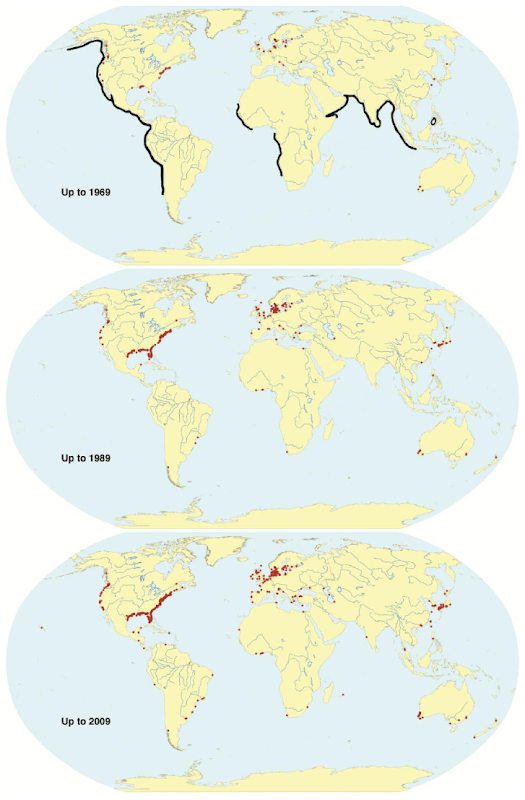Graph of the Day: Coastal Ocean Hypoxia Events, 1969-2009
Global pattern in the development of coastal hypoxia. Each red dot represents a documented case related to human activities. Number of hypoxic sites is cumulative through time. Black lines represent continental shelf areas threatened with hypoxia from expansion of OMZ and upwelling. Modified from Díaz and Rosenberg (2008) and Levin et al. (2009a). Over the past five to ten years, changes in the ocean’s dissolved oxygen content have become a focal point of oceanic research. The oxygen content in the open ocean appears to have decreased in most (but not all) areas (Gilbert et al., 2009). At the same time, low oxygen areas, also known as “dead zones”, have spread in the coastal oceans during the last five decades. These changes in oxygen are an increasingly important topic due to large impacts on the ecosystems, living resources, and biogeochemical cycles. Hypoxic (low dissolved oxygen) and anoxic (no oxygen) aquatic environments have occurred through geologic time. In fact, the biological and physical processes that formed large deposits of oil in geologic formations are the same as those occurring in oil rich areas where hypoxia and anoxia exist presently, such as the Santa Barbara Basin, California, USA, a silled basin interacting with an oxygen minimum zone (Berelson, 1991), and the continental shelf of the northern Gulf of Mexico adjacent to the outflow of the Mississippi River (Rabalais et al., 2007b). Low oxygen waters in the world oceans are normal, or naturally formed, in areas such as oxygen minimum zones (OMZs), deep basins, upwelling areas of eastern boundary currents, and fjords (Helly and Levin, 2004). But in the 19th, 20th and 21st centuries, the activities of humans have resulted in many more areas of hypoxia than occurred historically and aggravated conditions in areas that were already low in oxygen (Fig. 1) (Díaz and Rosenberg, 1995, 2008; Vaquer-Sunyer and Duarte, 2008; Gooday et al., 2009b). In contrast to what occurs in the OMZs and upwelling zones, much of the hypoxia and anoxia in shallow coastal marine areas has developed within the last 50 yr and is closely associated with anthropogenic activities.Díaz and Rosenberg (1995) noted that no other environmental variable of such ecological importance to estuarine and coastal marine ecosystems has changed so drastically, in such a short period of time. They noted consistent trends of increasing severity in duration, intensity, or extent in areas where hypoxia has a long history, which were coincidental with an increase in human activities. In 1995 there were 195 literature documented areas of human-caused coastal hypoxia. In their most recent compilation, Díaz and Rosenberg (2008) documented just over 400 such areas in the world’s coastal ocean covering more than 245 000 km2 of sea bottom (Fig. 1). The worldwide distribution of coastal hypoxia is related to major population centers or is closely associated with developed watersheds that export large quantities of nutrients, specifically nitrogen and phosphorus. Up to 1970, there were scattered reports of hypoxia in North America and northern Europe. By the 1990s, coastal hypoxia was prevalent in North America, northern Europe, and Japan. By the 2000s, there were increased reports of hypoxia in South America, southern Europe, and Australia (Fig. 1). Considering the close association of human population and hypoxia, it is unlikely that Asia and the Indo-Pacific have no hypoxia.
N. N. Rabalais, R. J. Díaz, et al., Dynamics and distribution of natural and human-caused hypoxia [pdf], Biogeosciences, 7, 585–619, 2010

And this won't help either:
http://news.yahoo.com/s/ap/20100226/ap_on_sc/as_australia_icebergs
"There may be regions of the world's oceans that lose oxygen, and then of course most of the life there will die," said Mario Hoppema, chemical oceanographer at the Alfred Wegener Institute for Polar and Marine Research in Germany.
Would underwater volcanic activity also play a part in this?